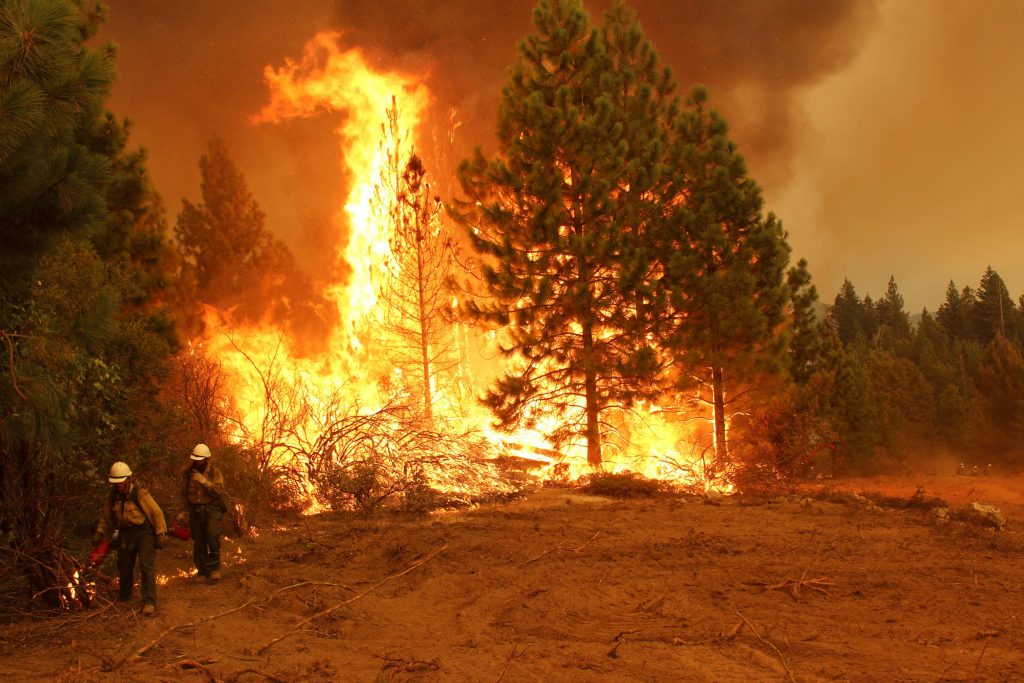What the Wildfire Funding Fix Means for Recreation
Posted: April 16, 2018Source: REI

Firefighters battle the Rim Fire on California’s Stanislaus National Forest in 2013. (Photo Courtesy: The National Forest Foundation and U.S. Forest Service; Mike McMillan,Photographer)
Following the devastating and deadly wildfires of 2017, federal lawmakers agreed last week—after years of negotiation—to change the way wildland firefighting is funded. Congress included the reform as part of the $1.3 trillion spending bill, which President Trump signed into law on Friday.
The funding fix helps avoid “fire borrowing” and treats large-scale wildfires similarly to other natural disasters. Starting in fall 2019, if the wildfire suppression budget runs out, instead of borrowing money from other programs, the U.S. Forest Service and the Department of the Interior can pull from a $2.25 billion emergency fund. For people who love the outdoors, that means more money remains dedicated to trail stewardship, facilities maintenance, forest health and recreation services.
Right now, the Forest Service’s fire suppression budget is based on the 10-year average of firefighting costs. John Rapp, acting budget director for the Forest Service, says those costs have risen about $100 million a year for the past three years alone.
As a result, fire suppression accounts for a bigger chunk of the agency’s budget, which has remained relatively flat in recent years. When the Forest Service maxes out its firefighting funds, initially budgeted for $1.8 billion in 2017, Rapp says the agency transfers money from other accounts to fight fires. It borrowed more than $526 million last year. Until now, the Forest Service and the Department of the Interior have been the only two agencies that use discretionary dollars, instead of emergency funds, to respond to natural disasters.
“They have to basically raid every other Forest Service account, and it is agency wide. It’s research, recreation, forest management, water work, state and private work,” National Forest Foundation president Mary Mitsos said.
2017 marked the most expensive year on record, with the Forest Service spending at total of $2.4 billion on wildfire suppression. That’s more than half of the agency’s overall budget. In total, more than 9.7 million acres burned last year, the third most on record.
Although Congress eventually repays the transferred funds, Rapp says fire borrowing delays projects.
“It’s disruptive. It’s disruptive to the partners who work with us on the projects. It’s disruptive to the people on the ground. … And it can be disruptive in terms of the overall land management goals,” he said.
In addition to greatly reducing the risk of fire borrowing, the funding fix caps the Forest Service’s routine wildfire suppression budget at the 10-year average in 2015—a little more than $1 billion, according to Rapp. That change also takes effect in the 2020 fiscal year. Between now and then, Rapp says wildfire funding remains the status quo, with the fire suppression budget still based on the current 10-year average. Congress allocated an extra $500 million for 2018, bringing the total budget for firefighting to more than $1.5 billion.
Rapp says the cap along with the emergency fund, which increases $100 million each year to $2.95 billion in 2027, will provide “some consistency in terms of how we’re able to budget and consistency in terms of how we’re able to look at the needs of the land and the needs of the people who use that land.”
Although wildfire suppression will remain a large part of the Forest Service’s annual budget, Mitsos agrees the change helps eliminate uncertainty, a benefit for people who use the 154 national forests and 20 grasslands managed by the agency.
“Now, money won’t be pulled from trail stewardship and maintenance midyear. [You’ll] have more assurances that you have good access and decent facilities where you do recreate,” Mitsos said. She says the funding fix could help reduce the risk of wildfires, adding, “[The Forest Service will] have more assurances of what they can spend on projects, like thinning and forest management, [that] help reduce the risk of big wildfires.” The spending bill includes forest management reforms, as well.
Over the last five years, REI, the Outdoor Industry Association (OIA) and other conservation and sportsmen’s groups have advocated for a change to wildfire funding. The co-op, along with other stakeholders, applaud the bipartisan support for the funding fix.
“Few people realize it, but the national forests are home to thousands of miles of trail and thousands of campsites,” said Marc Berejka, REI’s director of government and community affairs. “The Forest Service is one of the largest hosts of campers and hikers in the country. To have the [agency] suffer ongoing erosion of its budget to maintain trails and campsites meant that we were losing access to the campsites and trails that so many of our members use.”
OIA executive director Amy Roberts agreed the funding fix will help.
“By stopping the practice of borrowing money, Congress has assured communities and businesses, particularly in the West, that recreation, conservation and other public land funding accounts won’t get siphoned when wildfires strike and that the necessary resources will be there when firefighting season begins in earnest,” Roberts said in a statement.
The overall spending bill passed the House 256-167, with more than 100 members from each party voting “for.” In the Senate, more than two dozen Republicans and more than three dozen Democrats joined forces to pass the bill.
“That’s a degree of shared purpose seldom seen lately, but worth a call out,” Berejka said.
